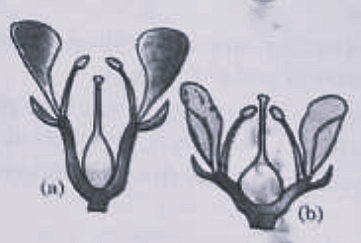Question:
Identify the set of correct statement:
A. The flowers of Vallisneria are colourful and produce nectar.
B. The flowers of waterlily are not pollinated by water.
C. In most of water-pollinated species, the pollen grains are protected from wetting.
D. Pollen grains of some hydrophytes are long and ribbon like.
E. In some hydrophytes, the pollen grains are carried passively inside water.
Choose the correct answer from the options given below
Identify the set of correct statement:
A. The flowers of Vallisneria are colourful and produce nectar.
B. The flowers of waterlily are not pollinated by water.
C. In most of water-pollinated species, the pollen grains are protected from wetting.
D. Pollen grains of some hydrophytes are long and ribbon like.
E. In some hydrophytes, the pollen grains are carried passively inside water.
Choose the correct answer from the options given below
A. The flowers of Vallisneria are colourful and produce nectar.
B. The flowers of waterlily are not pollinated by water.
C. In most of water-pollinated species, the pollen grains are protected from wetting.
D. Pollen grains of some hydrophytes are long and ribbon like.
E. In some hydrophytes, the pollen grains are carried passively inside water.
Choose the correct answer from the options given below
Updated On: Aug 28, 2025
- C, D and E only
- A, B, C and D only
- A, C, D and E only
- B, C, D and E only
Hide Solution
Verified By Collegedunia
The Correct Option is D
Solution and Explanation
The problem asks which statements about different flowering plants are correct. Let's analyze each statement:
- A. The flowers of Vallisneria are colourful and produce nectar.
Vallisneria is a submerged aquatic plant whose flowers are generally pale and do not produce nectar, as they do not rely on insect pollination. Hence, statement A is incorrect. - B. The flowers of waterlily are not pollinated by water.
Water lilies are primarily pollinated by insects and not water. Hence, statement B is correct. - C. In most water-pollinated species, the pollen grains are protected from wetting.
Water-pollinated species tend to have adaptations to prevent pollen grains from getting wet, such as hydrophobic surfaces. This statement is correct. - D. Pollen grains of some hydrophytes are long and ribbon-like.
This is an adaptation to efficiently travel through water and reach the female flower. This statement is correct. - E. In some hydrophytes, the pollen grains are carried passively inside water.
Some hydrophytic plants release pollen into the water to passively reach other plants. This statement is correct.
Based on this analysis, the correct set of statements is B, C, D, and E, matching the option: B, C, D and E only.
Was this answer helpful?
8
1
Top Questions on The Flower
- Match List I with List II
List I (Types of Stamens) List II (Example) A Monoadelphous I Citrus B Diadelphous II Pea C Polyadelphous III Lily D Epiphyllous IV China-rose
Choose the correct answer from the options given below:- NEET (UG) - 2024
- Biology
- The Flower
- Which of the following is an example of actinomorphic flower?
- NEET (UG) - 2024
- Biology
- The Flower
- Identify the type of flowers based on the position of calyx, corolla and androecium with respect to the ovary from the given figures (a) and (b).

- NEET (UG) - 2024
- Biology
- The Flower
- Identify the correct description about the given figure.

- NEET (UG) - 2024
- Biology
- The Flower
- Flowers having both the stamens and carpels are called
- TS POLYCET - 2023
- Biology
- The Flower
View More Questions
Questions Asked in NEET exam
Three identical heat conducting rods are connected in series as shown in the figure. The rods on the sides have thermal conductivity 2K while that in the middle has thermal conductivity K. The left end of the combination is maintained at temperature 3T and the right end at T. The rods are thermally insulated from outside. In steady state, temperature at the left junction is \(T_1\) and that at the right junction is \(T_2\). The ratio \(T_1 / T_2\) is

- NEET (UG) - 2025
- Conductivity-thermal and electrical
- With the help of the given pedigree, find out the probability for the birth of a child having no disease and being a carrier (has the disease mutation in one allele of the gene) in the F3 generation.

- NEET (UG) - 2025
- Genetics
- Consider the diameter of a spherical object being measured with the help of a Vernier Callipers. Suppose its 10 Vernier Scale Divisions (V.S.D.) are equal to its 9 Main Scale Divisions (M.S.D.). The least count in the M.S. is 0.1 cm and the zero of V.S. is at -0.1 cm when the jaws of Vernier callipers are closed. If the main scale reading for the diameter is \(M = 5\) cm and the number of coinciding vernier division is 8, the measured diameter after zero error correction, is:
- NEET (UG) - 2025
- Measurement of length
- The plates of a parallel plate capacitor are separated by d. Two slabs of different dielectric constant \(K_1\) and \(K_2\) with thickness \(d/2\) and \(d/2\) respectively are inserted in the capacitor. Due to this, the capacitance becomes two times larger than when there is nothing between the plates. If \(K_1 = 1.25 K_2\), the value of \(K_2\) is :
- NEET (UG) - 2025
- Capacitors and Capacitance
- The correct order of the wavelength of light absorbed by the following complexes is:
A. $[ \text{Co(NH}_3\text{)}_6]^{3+}$
B. $[ \text{Co(CN)}_6]^{3-}$
C. $[ \text{Cu(H}_2\text{O)}_4]^{2+}$
D. $[ \text{Ti(H}_2\text{O)}_6]^{3+}$
Choose the correct answer from the options given below:- NEET (UG) - 2025
- Coordination chemistry
View More Questions